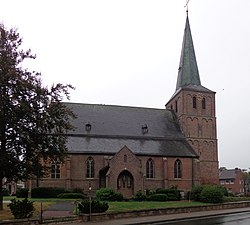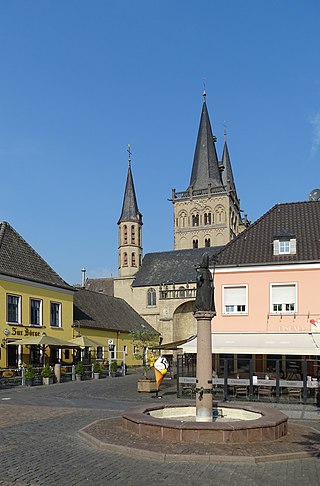
Xanten is a town in the state of North Rhine-Westphalia, Germany. It is located in the district of Wesel.

The Duchy of Cleves was a state of the Holy Roman Empire which emerged from the medieval Hettergau. It was situated in the northern Rhineland on both sides of the Lower Rhine, around its capital Cleves and the towns of Wesel, Kalkar, Xanten, Emmerich, Rees and Duisburg bordering the lands of the Prince-Bishopric of Münster in the east and the Duchy of Brabant in the west. Its history is closely related to that of its southern neighbours: the Duchies of Jülich and Berg, as well as Guelders and the Westphalian county of Mark. The Duchy was archaically known as Cleveland in English.

Weeze Airport, less commonly known as Niederrhein Airport, is a minor international airport in the Lower Rhine region of Germany. It is used by Ryanair. The airport is situated 3.7 km (2.3 mi) southwest of the municipality of Weeze and 7 km (4.3 mi) northwest of Kevelaer, about 33 km (21 mi) southeast of the Dutch city of Nijmegen, and 48 km (30 mi) northwest of the German city of Duisburg.

Geldern is a city in the federal German state of North Rhine-Westphalia. It is part of the district of Kleve, which is part of the Düsseldorf administrative region. The nearby Dutch province of Gelderland is named after this city.

Operation Veritable was the northern part of an Allied pincer movement that took place between 8 February and 11 March 1945 during the final stages of the Second World War. The operation was conducted by Field Marshal Bernard Montgomery's Anglo-Canadian 21st Army Group, primarily consisting of the First Canadian Army under Lieutenant-General Harry Crerar and the British XXX Corps under Lieutenant-general Brian Horrocks.

Weeze is a municipality in the Lower Rhine (Niederrhein) region, located in the northwestern part of North Rhine-Westphalia, specifically in the district of Kleve and the Düsseldorf region.

The Verkehrsverbund Rhein-Ruhr, abbreviated VRR, is a public transport association (Verkehrsverbund) in the German state of North Rhine-Westphalia. It covers most of the Ruhr area, as well as neighbouring parts of the Lower Rhine region, including Düsseldorf and thus large parts of the Rhine-Ruhr conurbation. It was founded on 1 January 1980, and is Europe’s largest body of such kind, covering an area of some 5,000 km2 (1,900 sq mi) with more than 7.8 million inhabitants, spanning as far as Dorsten in the north, Dortmund in the east, Langenfeld in the south, and Mönchengladbach and the Dutch border in the west.

Rees is a town in the district of Kleve in the state of North Rhine-Westphalia, Germany. It is located on the right bank of the Rhine, approximately 20 km east of Kleve. The population in 2005 was 22,559. Founded in 1228, Rees is the oldest town in the lower Rhine area.
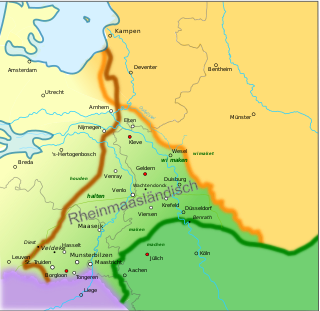
In linguistics, Meuse-Rhenish is a term with several meanings, used both in literary criticism and dialectology.

The Lower Rhine region or Niederrhein is a region around the Lower Rhine section of the river Rhine in North Rhine-Westphalia, Germany, between approximately Oberhausen and Krefeld in the East and the Dutch border around Kleve in the West. As the region can be defined either geographically, linguistically, culturally, or by political, economic and traffic relations throughout the centuries, as well as by more recent political subdivisions, its precise borders are disputable and occasionally may be seen as extending beyond the Dutch border.

The Duisburg-Ruhrort–Mönchengladbach railway is a historically significant, but now partly abandoned line in the German state of North Rhine-Westphalia. The line was built by the Ruhrort-Crefeld District Gladbach Railway Company, founded in 1847, and is one of the oldest lines in Germany, opened in 1849 and 1851.
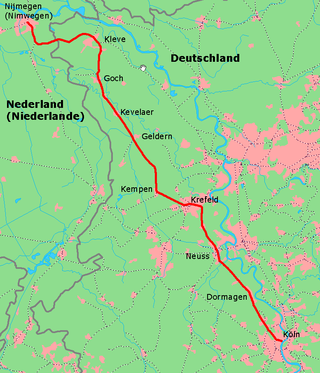
The Left Lower Rhine line is a main line on the left (western) bank of the Rhine in the lower Rhine region of the German state of North Rhine-Westphalia, running from Cologne to Cleves (Kleve) and formerly via Kranenburg to Nijmegen in the Netherlands. The Cologne–Krefeld section of the line was opened by the Cöln-Crefeld Railway Company in 1855 and is one of the oldest lines in Germany.

Moyland Castle is a moated castle in Bedburg-Hau in the district of Kleve, one of the most important neo-Gothic buildings in North Rhine-Westphalia. Its name derives from the Dutch word Mooiland which means "beautiful country". The name was probably coined by Dutch workers, whom the then-leaseholder Jacob van den Eger of the Lower Rhine brought to the property in 1307 to drain the surrounding wetlands.
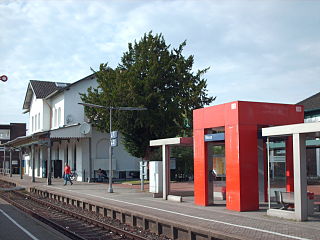
Weeze is a railway station in the village of Weeze, North Rhine Westphalia, Germany. The station opened on 5 March 1863 on the Lower Left Rhine Railway. The train services are operated by NordWestBahn.

The County of Moers was a historical princely territory on the left bank of the Lower Rhine that included the towns of Moers and Krefeld as well as the surrounding villages and regions.
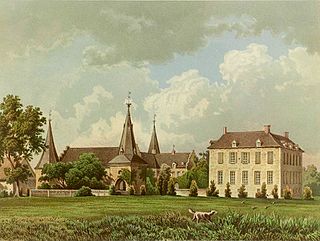
Castle Haag was a moated castle in the Rhineland region of Germany. It is located in Geldern in the district of Kleve, North Rhine-Westphalia. It is owned by the Van Hoensbroeck family.

Saint Gerebern was an Irish priest who baptized Saint Dymphna when she was a child. He was her companion when she fled to Belgium, where he was murdered beside her. His relics were taken to Sonsbeck in Germany, where they were an object of pilgrimage until they were destroyed during World War II. His feast day is 15 May.

Helmut Linssen is a German politician (CDU). From June 24, 2005, to July 15, 2010, he was finance minister of the state of North Rhine-Westphalia, immediately afterwards federal treasurer of the CDU. On February 6, 2014, following increasing pressure after his tax haven deals became known, he announced his retirement.
Princess Isabelle of Salm-Salm was the child of Emanuel, Hereditary Prince of Salm-Salm and member of the House of Salm-Salm. She was the longest lived royal European centenarian to have ever lived.
